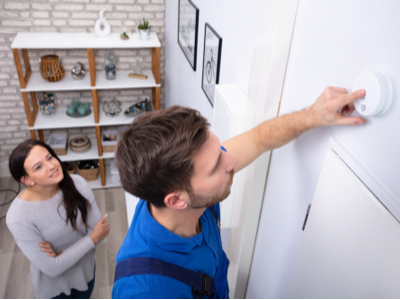October 23, 2023
The Dangers of Carbon Monoxide
You can’t see it, hear it, or smell it… but it’s there. Carbon monoxide – the silent killer – takes the lives of nearly 500 people every year and sends another 50,000 to the emergency room. Unfortunately, many of these situations could have been easily avoided.
Protect yourself from carbon monoxide poisoning by understanding what it is and how to keep your family safe from the dangers of CO poisoning. Applewood believes in safe, healthy homes for all our Colorado neighbors. Here’s what you can do to avoid carbon monoxide in your home.
What is Carbon Monoxide?
Carbon monoxide is a poisonous gas that is a natural by-product of appliances and power tools that burn fuels like gas, oil, kerosene, wood or charcoal. Until recent tragic events, this fatal gas has been under-publicized and overlooked. However, it is the leading cause of accidental poisoning deaths in America. Common household appliances such as furnaces, boilers, water heaters and stoves give off carbon monoxide with incomplete combustions of flammable fuels. CO exposure can be caused by venting, leaks or blockages in the vent system, or cracks and corrosion in a furnace’s heat exchanger.
Since the tragic deaths in Aspen in 2008, Applewood Plumbing Heating & Electric has seen a rise in requests to install carbon monoxide detectors. Fortunately, the percentage of homes with CO detectors has risen from 13% to 42% but that means many homes are still vulnerable. Given that an estimated 94% of homes have fire alarms, we hope more of our customers will convert to combination smoke and carbon monoxide detectors.
What are symptoms of carbon monoxide poisoning?


Carbon monoxide is a tasteless, odorless and colorless gas that is undetectable except by sophisticated biometric, metal oxide or electrochemical sensors. It is a deceptive poisoning since symptoms can mimic the flu and other common illnesses. Other indicators that a family might be at risk are:
- Fatigue
- Headaches
- Dizzy spells
- Nausea
- Vomiting
- Confusion
People can succumb to carbon monoxide poisoning with very little discomfort. They fall asleep, have loss of consciousness and, in the extreme cases, die of exposure.
It is important not to ignore possible symptoms. If you or your family is feeling ill with symptoms common to carbon monoxide poisoning, evacuate your home immediately. Open doors and windows and turn off any potential sources. Contact your local emergency service crew for advice, and if necessary, tell your doctor you suspect carbon monoxide poisoning.
What Causes Carbon Monoxide in Your House?
Appliances in your home that don’t burn fuel properly could leak CO. Signs to watch for that indicate a carbon monoxide problem include:
- Streaks of soot around the service door of a gas appliance.
- Rust spots on flue pipes, boilers, furnaces or water heaters.
- A lazy, yellow flame with an oily smell in a natural gas furnace indicates inefficient fuel burning, and consequently high levels of carbon monoxide.
- Excessive moisture on basement windows and stale air can indicate poor ventilation.


5 Ways to protect against CO
There are some easy steps to take to protect your family from carbon monoxide poisoning:
1. Purchase a carbon monoxide detector.
- Check to see that it carries the UL (Underwriters laboratories) label.
- Purchase a detector with an alarm to alert you quickly and wake you up during the night.
2. Have your furnace or boiler regularly inspected.
- A licensed heating professional should check all connections to flue piping and vents for cracks, gaps, rust, corrosion or debris.
- Debris should be cleared off the burner and safety switches tested.
- Inspection should cover combustion chamber and heat exchanger for cracks, holes, metal fatigue or corrosion.
3. Have chimneys and vents inspected regularly.
- A qualified technician should inspect them for blockages caused by debris, animal nests or cave-ins.
- Be sure all vents are properly installed.
4. Don’t operate gasoline-powered engines in confined areas.
- Avoid running furnace and fireplaces simultaneously for long periods of time.
- Warm up cars only in an open garage.
- Never install boiler, furnace or water heater in an airtight enclosure.
5. Replace batteries in all detectors and alarms.
- Don’t forget backup batteries in hard wired detectors.
- Often carbon monoxide units are ineffective due to dead batteries. Applewood Plumbing Heating & Electric is combating this silent killer by installing units in customers’ homes and ensuring new batteries are installed in new and existing units with each customers visit – free of charge. That goes for smoke alarms as well. Applewood makes it their policy to provide a free battery check and replacement during each customer call.
Carbon Monoxide FAQ
The short answer is a single oxygen atom, but that atom makes a huge difference. While carbon monoxide is a harmful manmade gas, carbon dioxide is a naturally occurring compound that is a byproduct of breathing oxygen. It is also a byproduct of burning fossil fuels and becomes harmful when large concentrations trap heat within the earth’s atmosphere.
At a minimum you should have one on every level of your home. Ideally you install them near your bedrooms in the event they go off while you’re sleeping. Also make sure you have one in or above an attached garage.
Most detectors have a life expectancy of 5-7 years. The International Association of Fire Chiefs recommends changing you detectors every 5-6 years. Make sure you check and replace the batteries every six months.
No. Only heaters that use a combustible fuel like gas or propane can produce CO. Stay warm and stay safe on those cold Colorado winter nights.
If caught right away, opening a window can stop carbon monoxide from poisoning you. Vent the gas out of your home and have a professional address the source as soon as possible. CO is most dangerous when contained.
Don’t ignore it! Leave your home immediately, including all family members and pets. Call 911 and wait for the authorities to check your home and make sure it’s safe before you return. If you need to perform repairs, make sure you hire a licensed professional.
No. CO is completely odorless. Not even your dog’s heightened sniffer can detect it but they’ll certainly become ill from carbon monoxide in your home. Watch for unusual behavior and mood changes.
Denver and Boulder Carbon Monoxide Experts
Applewood Plumbing Heating & Electric has serviced thousands of Colorado homes. We take the time to make sure each is safe and that you’re protected against harmful home dangers like carbon monoxide. For questions about your home or to schedule service, please contact Applewood today.


